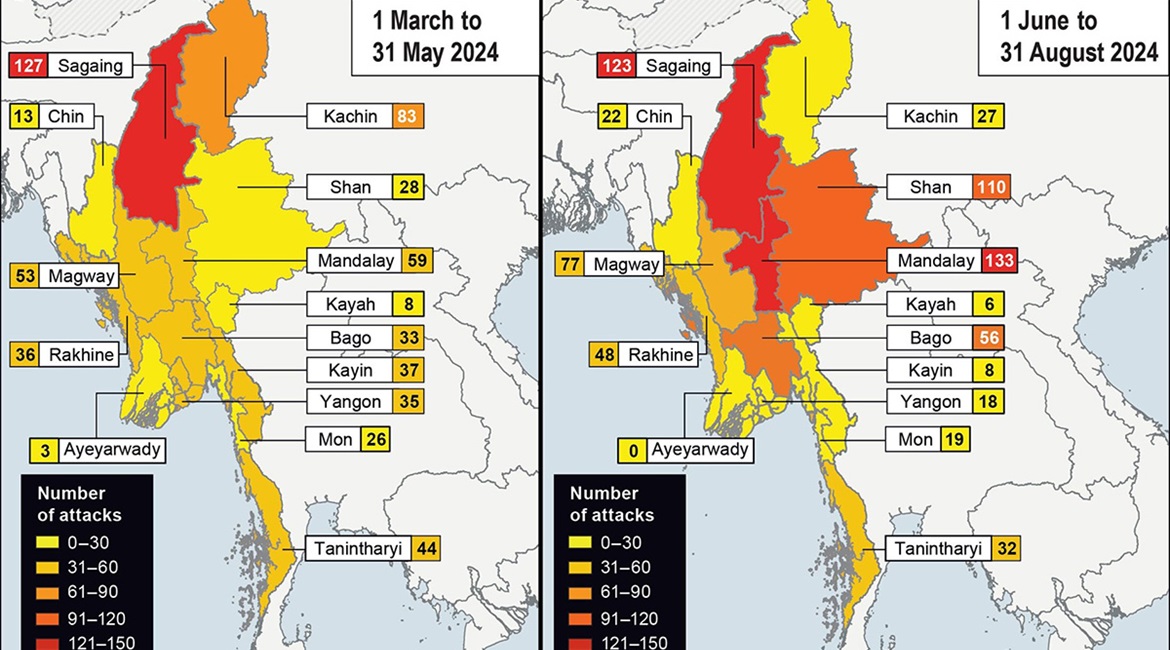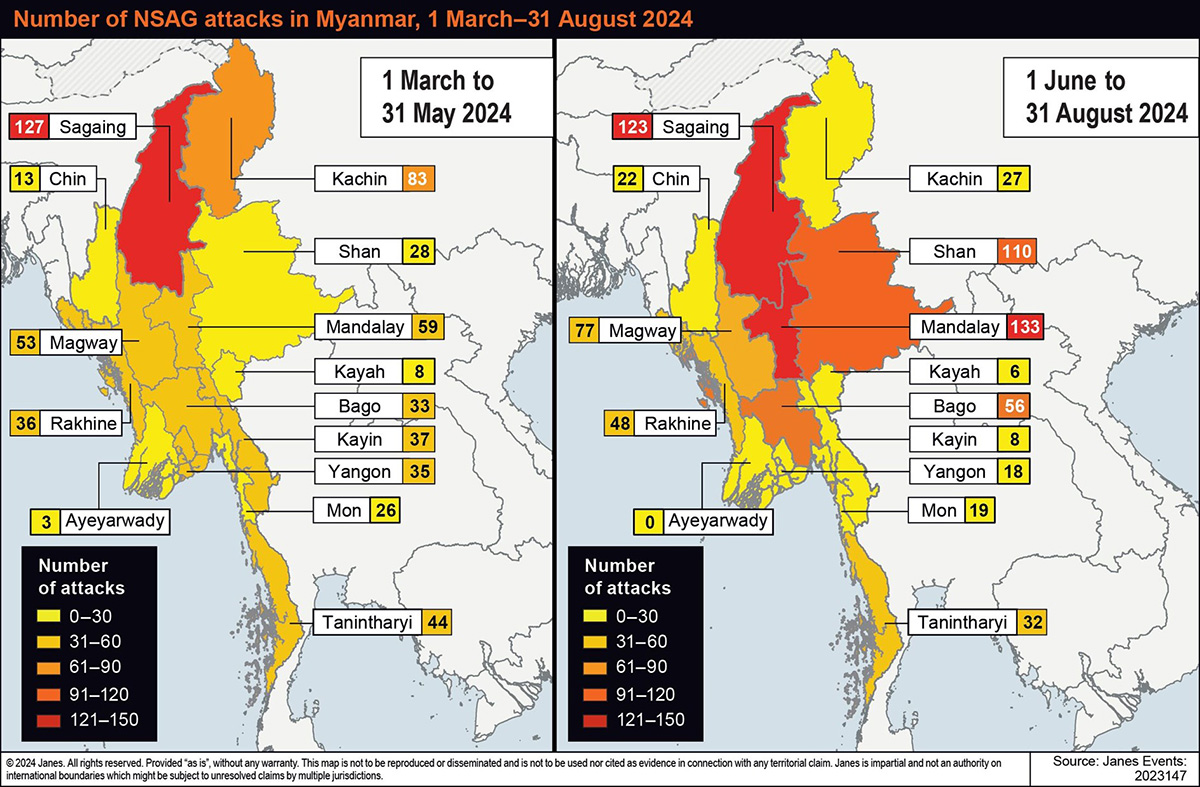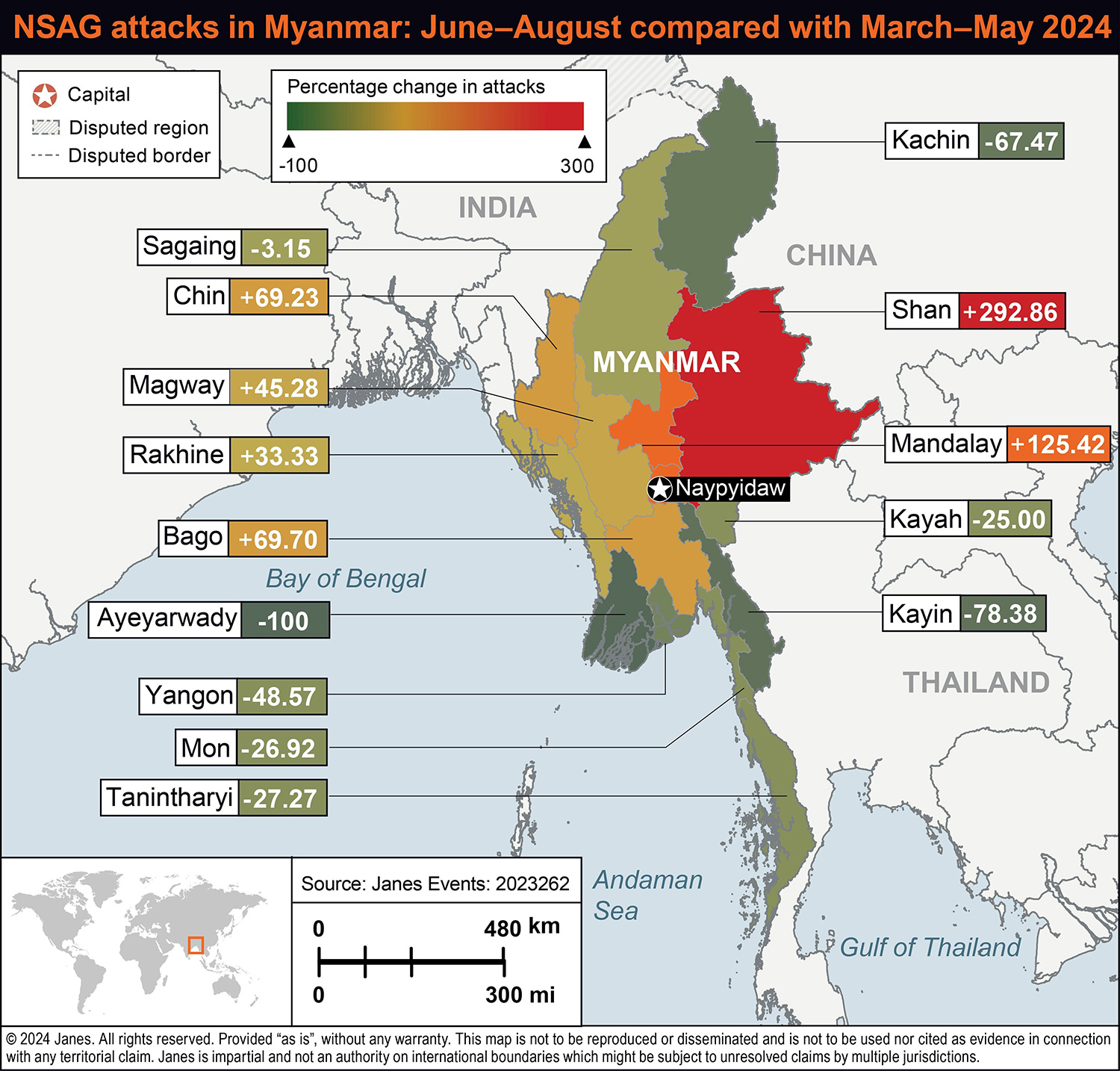
Date Posted: 06-Nov-2024
Author: Vaibhav Sharma, Bangalore Jack Nicholls, London, UK Nidhi Dalal, Bangalore
Key points
- At the time of publication, the SAC's position in central and southern Myanmar is vulnerable, with the Brotherhood Alliance NSAG coalition capturing several towns to the north and east of the city of Mandalay, including Lashio. By 31 August Rakhine State was predominantly under the control of AA militants
- The military continued to conduct airstrikes on militant positions, increasing risk to Chinese investments and infrastructure projects in Rakhine and Shan states, through which Chinese-funded oil and gas pipelines run. The military also formed a nationwide militia panel to train additional personnel at the ward and village levels
- Combat is almost certain to continue in the next three to six months, in part because there is no indication that external actors will successfully broker a nationwide ceasefire between the SAC and NSAGs in this timeframe. Also, combatant parties remain heavily engaged in combat operations, with the SAC very likely to launch an offensive to recapture the MNDAA-held town of Lashio in the next four weeks. Meanwhile, NSAGs such as the Brotherhood Alliance will very likely remain committed to the shared objective of overthrowing the SAC
Introduction
This report assesses developments in the Myanmar conflict between 1 June and 31 August 2024. It highlights the security implications of the fighting between the State Administration Council (SAC) and non-state armed groups (NSAGs) for control of military and civilian infrastructure in areas including the Mandalay and Sagaing regions and Rakhine and Shan states.
The report utilises Janes content alongside data published by think tanks, NGOs, local and national media outlets, and on social media platforms such as X (formerly Twitter) and Facebook.
Conflict overview
During this period, Janes recorded 678 attacks by NSAGs across the country between 1 June and 31 August 2024, compared with the 579 attacks between 1 March and 31 May 2024, an increase of 17.09%, indicating an intensification in the conflict.
 Intensity of attacks in Myanmar, 1 March–31 August 2024. (Janes Events)
Intensity of attacks in Myanmar, 1 March–31 August 2024. (Janes Events)
One likely driver behind this increase is the NSAGs' revival of ‘Operation 1027' (also referred to as Operation ‘1027 Phase Two/Part II') in late June. The armed wing of the Palaung State Liberation Front (PSLF), the Ta'ang National Liberation Army (TNLA), resumed attacks in northern Shan State on 25 June. The TNLA claimed that it had resumed attacks after the SAC conducted airstrikes violating the ceasefire agreed on 11 January in China's Kunming city. Under the ceasefire, members of the Brotherhood Alliance (also known as the Three Brotherhood Alliance) – comprising the Arakan Army (AA), the Myanmar National Democratic Alliance Army (MNDAA), and the TNLA – agreed to stop capturing camps and cities in northern Shan State, while the SAC agreed to end airstrikes and the use of heavy weaponry. An increase in attacks in mid-July also reflected the start of Operation ‘Shan-Man' by People's Defence Forces (PDF) militants, the National Unity Government (NUG), the MNDAA, and the TNLA across Shan State and Mandalay Region.

NSAG attacks in Myanmar: June–August compared with March–May 2024. (Janes Events)
NSAG attacks increased by 292.8% in Shan State and 125.4% in Mandalay Region as Operation ‘1027 Phase Two' almost certainly drove the significant uptick in attacks in Shan State and Mandalay Region. By 31 August the government remained predominantly in control of central and southern areas of Myanmar, also known as the Bamar heartland. However, the SAC lost command of northern Shan State as well as several roads leading to the country's second-largest city, Mandalay. Areas of Rakhine State under AA control also increased significantly, with the group controlling almost the entire province by the end of August.
As with the March to May 2024 period, analysis of Janes Events data indicates that combat between June and August was typically characterised by infantry-dominated battles for significant local infrastructure, including military installations, urban centres, and transport networks. Other features of the fighting included:
- The SAC's continued reliance on aircraft (using guided and unguided munitions) and artillery for offensive and defensive purposes to mitigate the loss of territorial control in border areas
- Enhanced military co-ordination between ethnic armed organisations (EAOs) such as the Brotherhood Alliance, and local PDFs, most notably in the Mandalay Region, to seize SAC-held urban centres
- The SAC's and NSAGs' continued deployment of unmanned aerial vehicles (UAVs) in combat and reconnaissance roles.
Domestic developments
State Administration Council
Janes assessment: Janes assesses that between June and August 2024 the military faced its most significant operational reversals since the beginning of ‘Operation 1027' and lost its key territories. The Myanmar military will very likely continue recruiting and mobilising conscripts to repel NSAG attacks, following government setbacks after the correspondent attacks started during the first phase of ‘Operation 1027' in October 2023. Acting President Senior General Min Aung Hlaing's political standing remains vulnerable because of the resumption of ‘Operation 1027' and close ties between old regime leaders and China.
As part of the Myanmar conscription process, on 24 June the third batch of conscripts arrived at military training centres across the country. According to The Irrawaddy news website, conscripts arrived at five-week intervals, with the first batch reported on 8 April, the second on 15 May, and the third on 22 June. On 25 June the Myanmar military confirmed that the first batch of 5,000 conscripts would deploy by the end of June. Using NATO's Admiralty Code for source reliability and credibility, Janes assesses this source as B2 for reliability (usually reliable) and accuracy (probably true); the media outlet is independent. However, the location for the deployment has not been confirmed. The deployment of conscripts reflects the junta's aims to recruit 60,000 soldiers in a year as stated in a 16 February The Irrawaddy article. Janes assesses that the mobilisation of conscripts is very unlikely to deter NSAG attacks, given increased attacks targeting the military since ‘Operation 1027' began in October 2023.
Sr Gen Hlaing has made efforts to strengthen his political standing since 2021, likely to minimise threats to his leadership. On 22 July he declared himself the president of the Republic of the Union of Myanmar after former President U Myint Swe transferred power to Commander-in-Chief Sr Gen Hlaing due to his deteriorating health. Sr Gen Hlaing's declaration was likely an attempt to consolidate power and exert more control over the National Defence and Security Council (NDSC). The public and legal experts – for example, lawyers and political analysts – criticised the move and deemed it unconstitutional. Also, the elite circle of military leaders and prominent Buddhist figures have criticised Sr Gen Hlaing for his incompetency in handling the ongoing conflict. According to articles 412(b) and 419 of the military-drafted constitution, the commander-in-chief is authorised to replace the president in exercising executive power and heading the NDSC, said military spokesperson Zaw Min Tun. According to a 24 July article on The Irrawaddy, Article 418 states that legislative, executive, and judicial powers shall be transferred but makes no mention of the commander-in-chief assuming the role of president or acting president.
The SAC extended the state of emergency for another six months on 31 July as the war escalated in areas including western and northeastern states of Myanmar. In a statement released in state-run newspaper The Global New Light of Myanmar on 1 August, the junta highlighted election preparations as the main reason for this decision, stating that a nationwide census would be required to conduct proposed elections in 2025. The Irrawaddy reported on 1 August that the regime announced that elections would be conducted only in areas that are under military control and noted that it would be impossible to conduct co-ordinated nationwide elections.
The military will likely conduct election preparations in stages after losing control of territories in northern Shan and western Rakhine states. The military is likely showcasing its commitment and efforts to international agencies to conduct elections as it has done in the past since the coup started in 2021. The regime further claimed that it would bring peace and stability to Lashio, Nawnghkio, Kyaukme, Hsipaw, and Mogok townships that are under the control of members of the Brotherhood Alliance. However, Janes assesses that there is a roughly even chance that the military will be able to re-capture these areas in the next three months, given significant losses of manpower, trade routes, and military bases in the area.
After facing continuous attacks from the Brotherhood Alliance and losing key towns, outposts, and a regional command on 3 August, the military formed a nationwide militia panel. According to The Irrawaddy on 20 August, the Myanmar junta Border Affairs Minister, Lieutenant General Tun Tun Naung, formed a ‘Central Supervisory Committee for People's Security and Anti-Terrorism Panel' to train, arm, and supply militias at the ward and village levels. Furthermore, military spokesperson Zaw Min Tun announced on 27 August that the military regime plans to recruit men older than 35 across the country. Since enforcing the conscription law in February, the military has intensified its monitoring activities at airports of men and women between the ages of 18 and 35 attempting to leave and evade mandatory conscription. Janes assesses that the formation of a new anti-terrorism panel and conscripting men older than 35 are a result of the junta's loss of its regional northeastern military command in northeastern Shan State. The move will very likely create fear among ethnic minorities at village and ward levels, prompting them to join anti-regime forces or flee the country.
For more information, please see Myanmar conflict report, June - August 2024






